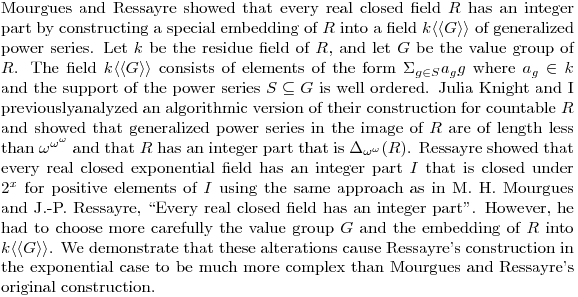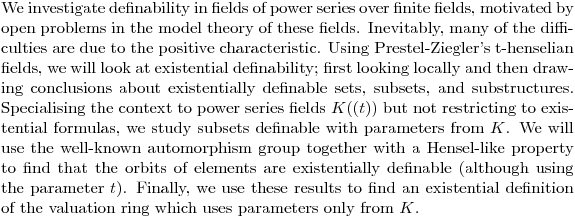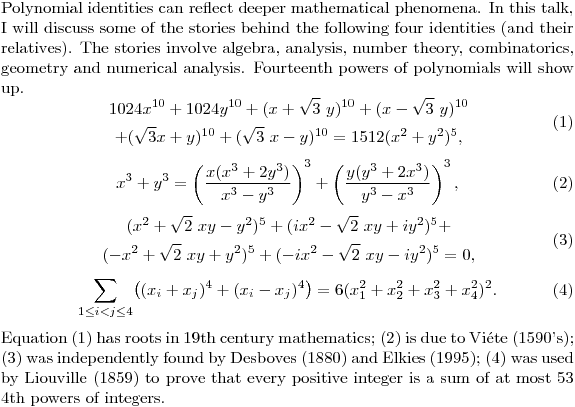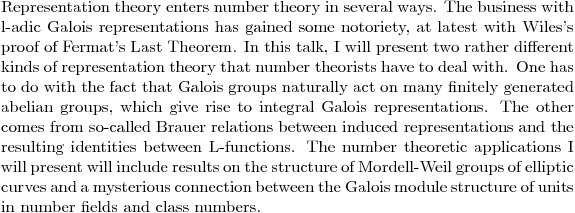Vorträge im Sommersemester 2011
Die folgenden Vorträge haben im Sommersemester 2011 im Oberseminar reelle Geometrie und Algebra, im Oberseminar Modelltheorie und im Schwerpunktskolloquium reelle Geometrie und Algebra stattgefunden.
Donnerstag, 14.04.2011 um 16.00 Uhr, Oberseminar Modelltheorie
Bijan Afshordel (Freiburg)
(Gast von Arno Fehm)
Beschränkte PAC-Unterstrukturen von stabilen
Strukturen



Freitag, 15.04.2011 um 14.15 Uhr, Oberseminar Reelle Geometrie und Algebra
Arne Grenzebach (Bremen)
(Gast von Salma Kuhlmann)
Der Satz von Cayley-Bacharach



Dienstag, 19.04.2011 um 16.15 Uhr, Oberseminar Modelltheorie
Martin Hils (Paris 7)
(Gast von Itay Kaplan)
Bad fields and uniformity results in Kummer theory





Freitag, 29.04.2011 um 14.15 Uhr, Oberseminar Reelle Geometrie und Algebra
Daniel Plaumann (Konstanz)
Der Satz von Cayley-Bacharach II


Dienstag, 03.05.2011 um 16.15 Uhr, Oberseminar Modelltheorie
Christoph Hanselka (Konstanz)
Sums of 2m-th Powers (Part II)


Freitag, 06.05.2011 um 14.15 Uhr, Oberseminar Reelle Geometrie und Algebra
Annalisa Conversano (Konstanz)
The commutator subgroup of a semialgebraic group


Dienstag, 10.05.2011 um 16.15 Uhr, Oberseminar Modelltheorie
Annalisa Conversano (Konstanz)
Connected components of groups and o-minimality
(joint papers with Anand Pillay)


Freitag, 13.05.2011 um 14.15 Uhr, Oberseminar Reelle Geometrie und Algebra
Tobias Kaiser (Passau)
(Gast von Salma Kuhlmann)
Zahme Maße




Dienstag, 17.05.2011 um 16.15 Uhr, Oberseminar Modelltheorie
Karen Lange (Notre Dame)
(Gast von Salma Kuhlmann)
Limit computable integer parts










Freitag, 20.05.2011 um 14.15 Uhr, Oberseminar Reelle Geometrie und Algebra
Roland Speicher (U. des Saarlandes, Saarbrücken)
(Gast von Salma Kuhlmann)
Was sind und was sollen Quantenpermutationen
oder
Quantum Groups Made Easy


D ienstag, 24.05.2011 um 16.15 Uhr, Oberseminar Modelltheorie
Karen Lange (Notre Dame)
(Gast von Salma Kuhlmann)
Generalized power series and real closed fields







Donnerstag, 26.05.2011 um 17.00 Uhr, Schwerpunktskolloquium Reelle Geometrie und Algebra
Hans Mittelmann (Arizona State University)
(Gast von Cordian Riener)
Computing Strong Bounds in Combinatorial Optimization



Freitag, 27.05.2011 um 14.15 Uhr, Oberseminar Reelle Geometrie und Algebra
Ken Dykema (Texas A&M)
(Gast von Markus Schweighofer)
Sofic dimension


Donnerstag, 09.06.2011 um 16.15, Lectures on the geometry of plane quartic curves
Daniel Plaumann und Cynthia Vinzant
Announcement:
We plan a short informal series of lectures on the geometry of plane quartic curves, focussing on determinantal and sums-of-squares representations. The first session will be this Thursday, June 9, 16:15-18:00 in F426 with one talk by each of us. We will start with Dixon's construction of determinantal representations of plane curves, and the combinatorics of determinantal representations and the 28 bitangents of a plane quartic.
Freitag, 10.06.2011 um 14.15 Uhr, Oberseminar Reelle Geometrie und Algebra
Roland Abuaf (Institut Fourier, Grenoble)
(Gast von Rainer Sinn)
Theorems on tangencies in convex and projective geometry



Dienstag, 14.06.2011 um 16.15 Uhr, Oberseminar Modelltheorie
Itay Kaplan (Konstanz)
Groups in dependent theories


Freitag, 17.06.2011 um 14.15 Uhr, Oberseminar Reelle Geometrie und Algebra
Michael Wibmer (RWTH Aachen)
(Gast von Arno Fehm)
Algebraic difference equations and a theorem of Chevalley


Dienstag, 21.06.2011 um 16.15 Uhr, Oberseminar Modelltheorie
Martin Bays (Paris 7)
(Gast von Margaret Thomas)
Categoricity of Exponential Maps


Dienstag, 28.06.2011 um 16.15 Uhr, Oberseminar Modelltheorie
Will Anscombe (Oxford)
(Gast von Arno Fehm)
Aspects of definability in henselian fields of positive characteristic


Donnerstag, 30.06. um 17.00 Uhr, Kolloquium
Bruce Reznick (Urbana-Champaign)
(Gast von Claus Scheiderer)
The secret lives of polynomial identities


Freitag, 01.07.2011 um 14.15 Uhr, Oberseminar Reelle Geometrie und Algebra
Cynthia Vinzant (Berkeley)
(Gast von Daniel Plaumann)
The central curve of a linear program


Dienstag, 05.07.2011 um 16.15 Uhr, Oberseminar Modelltheorie
Katharina Dupont (Konstanz)
Definable Valuations




Freitag, 08.07.2011 um 14.15 Uhr, Oberseminar Reelle Geometrie und Algebra
Sebastian Wenzel (Konstanz)
Sums of squares and strip problem

![$Recently, M.Marshall answered a long outstanding question in algebraic geometry by showing that if $f\in\mathbb{R}[x,y]$ and $f \geq 0$ on the strip $[0,1]\times\mathbb{R}$, then $f$ has a representation $f = g + x(1-x) h$, where $g,h \in\mathbb{R}[x,y]$ are sums of squares.$](../typo3temp/math/00b2c40d64ab9d848cf5a76dbbb3dc83.png)

Dienstag, 12.07.2011 um 16.15 Uhr, Oberseminar Modelltheorie
Mikael Matusinski
Surreal numbers as exp-log series

![$In his monograph [Gon86], H. Gonshor showed that Conway’s real closed field of surreal numbers carries an exponential and logarithmic map. Subsequently, L. van den Dries and P. Ehrlich showed in [vdDE01] that it is a model of the theory of Rexp. Our aim is to show that surreal numbers form a field of exp-log series and transseries. This would help us, applying previous results of ours [KM11][Sch01], to endow the field of surreal numbers with a natural derivation.$](../typo3temp/math/72e5d40f3a64e415ff65f1f5a0a3132f.png)



![$[Gon86] H. Gonshor, An introduction to the theory of surreal numbers, London Mathematical Society Lecture Note Series, vol. 110, Cambridge University Press, Cambridge, 1986.$](../typo3temp/math/b1b0d8ebefee8d05b81ae169247a1320.png)
![$[KM11] S. Kuhlmann and M. Matusinski, Hardy type derivations on fields of exponential logarithmic series., to appear in J. Algebra, arxiv 1010.0896 (2011).$](../typo3temp/math/3ba86de365d29d276df308cf346091ab.png)
![$[Sch01] M.C. Schmeling, Corps de transséries, Ph.D. thesis, Université Paris-VII, 2001.$](../typo3temp/math/7dd4b97550b864ce13fd40fbf03dc48e.png)
![$[vdDE01] Lou van den Dries and Philip Ehrlich, Fields of surreal numbers and exponentiation, Fund. Math. 167 (2001), no. 2, 173–188.$](../typo3temp/math/90905c01b368382d4c7e0418710f9e2e.png)
Donnerstag, 14.07.2011 um 16.00 Uhr im Schwerpunktskolloquium Reelle Geometrie und Algebra
Alex Bartel (POSTECH in Pohang)
(Gast von Arno Fehm)
Yet another occurrence of group representations in number theory


Freitag, 15.07.2011 um 14.15 Uhr, Oberseminar Reelle Geometrie und Algebra
Jochen Koenigsmann (Oxford)
(Gast von Salma Kuhlmann)
On fields with the absolute Galois group of Q



